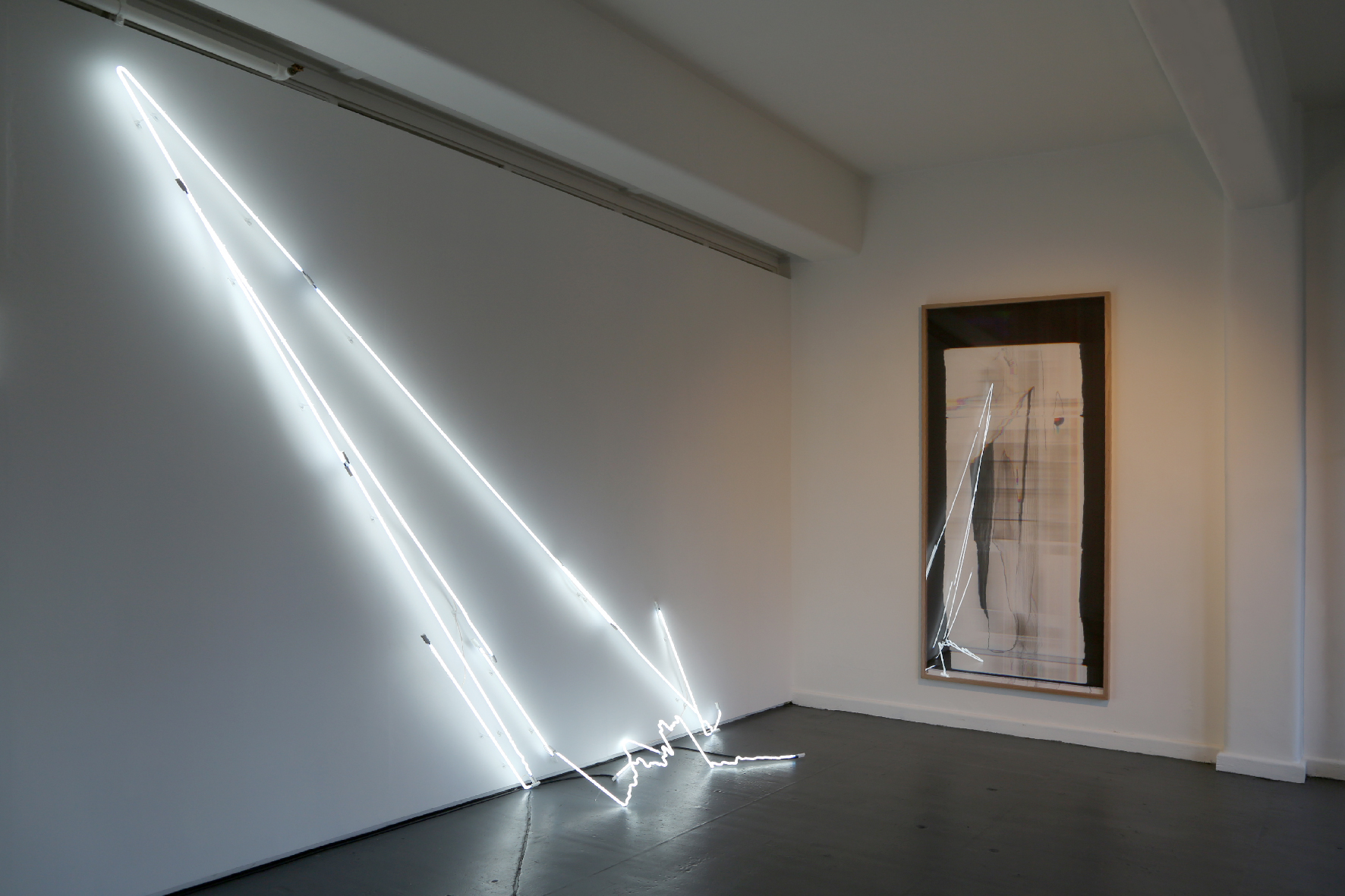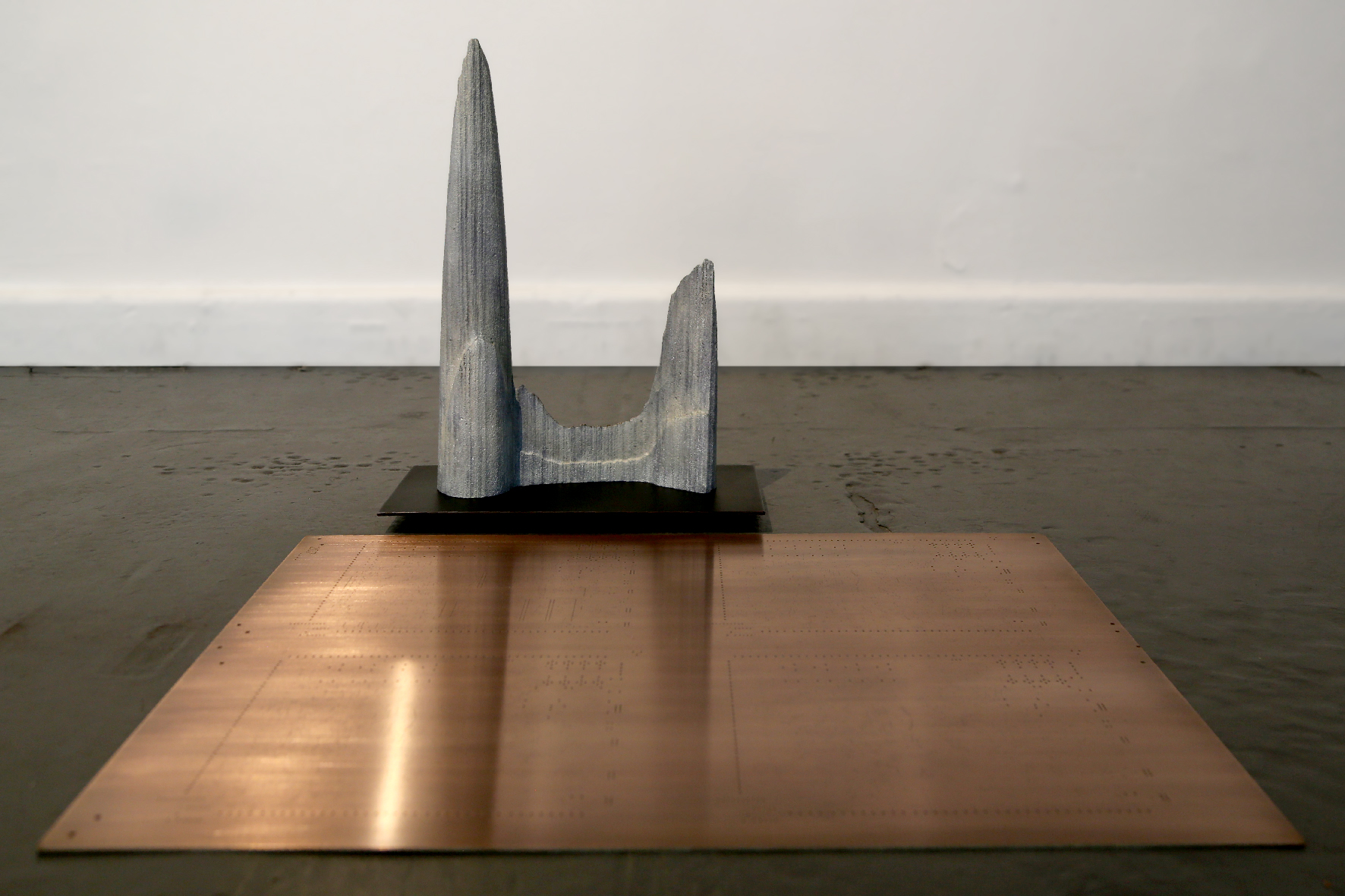





Liminal Trajectories moves from the astrophysical to the primordial, to the technological.
The exhibition crosses between field works and laboratory works, from the site of the Murchison Meteorite in North Victoria, to the site of CSIRO, Clayton. As part of the ANAT Synapse artist-in-residency, extensive research was undertaken working with the prebiotic material and investigating the phenomena of the meteorite intersecting earth in September 1969. Identified as one of the most primitive and profound astronomical bodies, the Murchison Meteorite comprises complex organic compounds, which ultimately forged the building blocks of life.
‘The Intersecting
Trajectories of Cosmic Matter’
by Sophie Knezic
Mineral matter hurtles through space, racing fireballs streak the sky with blinding incandescence, chondrite boulders fracture at ferocious speeds. Extreme velocities yield violent collisions, matter explodes into clusters of hurling debris fomenting maelstroms of sand. Combusting particulates disintegrate and disperse into opaque billows of stardust, superseding trails of stellar light. Such fierce atmospheric events are constant occurrences for meteorites; solid forms of rock and metal that rush through outer space for aeons, originating from distant planets. Dating back more than 4 billion years, these lumps of iron and stone are the oldest classes of objects we know, residual matter preceding the birth of the solar system, leftovers formed by ancient interplanetary collisions. Ejected into space, these metamorphic forms careen in contingent trajectories in a kind of intergalactic cosmic choreography. With intermittent frequency, they break through the troposphere and crash into the earth’s surface. The most recent striking episode of a meteorite crash landing occurred on Friday 15th February 2013 near the Russian city of Chelyabinsk. The icy asteroid – estimated at 20 metres in size – penetrated the earth’s atmosphere unforeseen and quickly heated into a huge fireball moving at 69,000 km an hour. Flaming brighter than the sun, its rapid motion streaked the atmosphere with an ephemeral, luminous flare. More recently, an asteroid estimated at 100 metres in diameter sped past Earth at 24 kilometres a second on 25th July this year. While its trajectory avoided a collision with our planet, its impact would have generated 30 times the energy of the Hiroshima atom bomb.
James Geurts is drawn to the potentiality such meteoritic events – although less for their powerful forces of impact than by the lure of primordial matter and micro-chemical interactions. These random clusters and collisions produce the celestial phenomena of intense light but they also spark more infinitesimal forms of agency. Attuned to their miniscule interactions, Geurts understands these phenomena as a speculative site for generative events. In a suite of works titled Trajectories he turns his attention closer to home and a little further into the past. On 28th September 1969, in the small Victorian town of Murchison, one such meteoritic event occurred: a cluster of galactic rock fragments dating back 4.6 billion years showered over a 13 square kilometre area of earth. The meteorite pieces (totalling almost 100 kg) were from a rare class of meteorite known as carbonaceous chondrite that collectively came to be named the Murchison Meteorite.
Many of the Murchison Meteorite fragments were covered with a fusion crust – which occurs when meteorites travelling through the atmosphere fracture and melt at the same time. They also comprised a large amount of presolar grains – silicon carbide, diamond, graphite, spinel, silicon nitride and aluminium oxide – granular materials formed in star systems that predate the existence of the solar system. This interstellar debris held living potentiality.
For what made the traces of the Murchison Meteorite special is that lab testing revealed them to contain organic compounds never previously detected in meteorites – genetic material akin to amino acids; the building blocks of DNA. In 2009 astrobiologists working at the Imperial College London extracted molecular particles of DNA and RNA known as nucleobases from the Meteorite fragments. Chemical analysis confirmed that the nucleobases were extraterrestrial. What does this mean? Simply that the primary genetic codes for life have existed not just on earth but in other parts of the solar systems. The elemental interactions of such ancient traces jolt primordial materials into incipient life: as genesis from matter. When the philosopher Michel Serres declares, ‘In the beginning are the meteors’, he enacts another amalgamate event: the fusing of physical cosmology with poesis. Poesis, from the ancient Greek ποίησις meaning ‘to make’, in Serres’ hands entwines the astrophysical with the metaphysical and the physicality, we might say, of language itself. ‘In the beginning are nameless words, verbs without nouns. Stone is bombarded by the unfurling of the wave, its crazy lace is the memory of the undertow: this fractal complexity is a trace of the multiple… The soft dune is blown across the sand, the earth cracks and breaks up in ice, the cloud dissipates in the midst of turbulences. … The immense tide of the multiple makes, unmakes, it passes, destroys or constructs… In the beginning is the multiple…’1 In parallel albeit material fashion, Geurts enacts his own cosmological fusions, melding astrophysics with an artist’s gaze, conjuring new multiplicities that pivot on linking the chemical, the aesthetic, the sculptural and the astrophotographic. For the exhibition’s title work, Trajectories I: Orbiting Bodies Meet (2019) Geurts accessed a fragment of the Murchison Meteorite that he 3D scanned, elongated and remade in neon, illuminating the Meteorite’s trajectory and physically attenuating its instant of impact.
At the Meteorite’s impact site, he exposed the chemical strata of photographic composite to the site’s atmosphere – its diffused matter, temperature and dust – allowing the components to layer and coalesce. The resulting work Trajectories III: Panspermia (2019), from the ancient Greek terms πᾶν [pan] meaning ‘all’ and σπέρμα [sperma] meaning ‘seed’, hovers between the microcosmic and macrocosmic, like algal blooms on a body of stagnant water, cross-sections of fossilised matter or damaged photographs of the Milky Way. A carbon work on paper based on field drawings the artist made at the site were digitally stretched in Trajectories IV: Carbon Marks (2019). With a dismantled scanner separated into component parts, the camera slowly grazed the drawing’s outlines, capturing and refracting light. Here distortion enacts a kind of poetic flux. Ancient strata filtered through the artist’s mark-making dilates into linear stutterings like the irregular lines of an EEG scan or abstract forms seen through patterned glass. Delayed motion also occurred in Trajectories II: Prebiotica (2019), where regulated drops of liquid prebiotic material slowly spilled onto a coated glass plate, pooling into gauzy layers of organic form. Geurts’ chemical experiments continued in Trajectories V: Satellite (2019) where a digital file of a drawing stored on a USB drive was soaked in prebiotic material, degrading the image into a colour field abstraction with abraded edges like decomposing matter, leaving a sparkly surface resembling a strip of diamond dust or cosmic white noise.
In his paean to cosmological turbulence, Serres finally concludes that the cosmos is not a structure so much as a complex of multiplicities, ‘a mixture, tiger-striped, motley, mottled, zebra-streaked, variegated… a mixed aggregate … an intermittence.’2 Geurts’ quasi-artistic, quasi-scientific experiments speak to these variegations and subtle fields of turbulence. With their liquid corrosions, schematic illuminations, reified patterns and stretched contours they project existing cosmologies into new matrices. They also materialise something of the celestial jolts that continually rent the universe – colliding orbits, pulverising rock and metal – as lineaments of congealed time. Geurts’ 2D and 3D formations visualise and decelerate these precipitate astrophysical events.
This project was supported through the ANAT Synapse program and CSIRO Advanced Manufacturing, with the assistance of Creative Victoria. In collaboration with CSIROscientists Dr Richard Evans and Dr Helmut Thissen, expanding on the Miller-Urey experiment 1952.
James Geurts draws out geographic and conceptual forms that are layered within specific sites of his research. The artist examines how natural and cultural forces shape perception. James works across the disciplines of drawing, sculpture, photography, video, and Public Art/Land Art. Exhibitions include: National Gallery of Victoria; White Cube, London; Gemak, The Hague, Netherlands; Centre for Contemporary Art, Tel Aviv Israel; Art Gallery of South Australia; Kuandu Museum of Fine Art, Taipei; La Chambre Blanche, Quebec; and the Australian Centre for Contemporary Art, and has recently been awarded the Australia Council for the Arts ACME London Studio residency, April - September 2020.
Melbourne based James Geurts studied Master of Fine Arts at RMIT University and undertook Post Graduate research at Vrije Academie, The Hague, Netherlands. Represented by GAGPROJECTS (Greenaway Art Gallery) Adelaide, Berlin and Contemporary Art Society, London jamesgeurts.com.